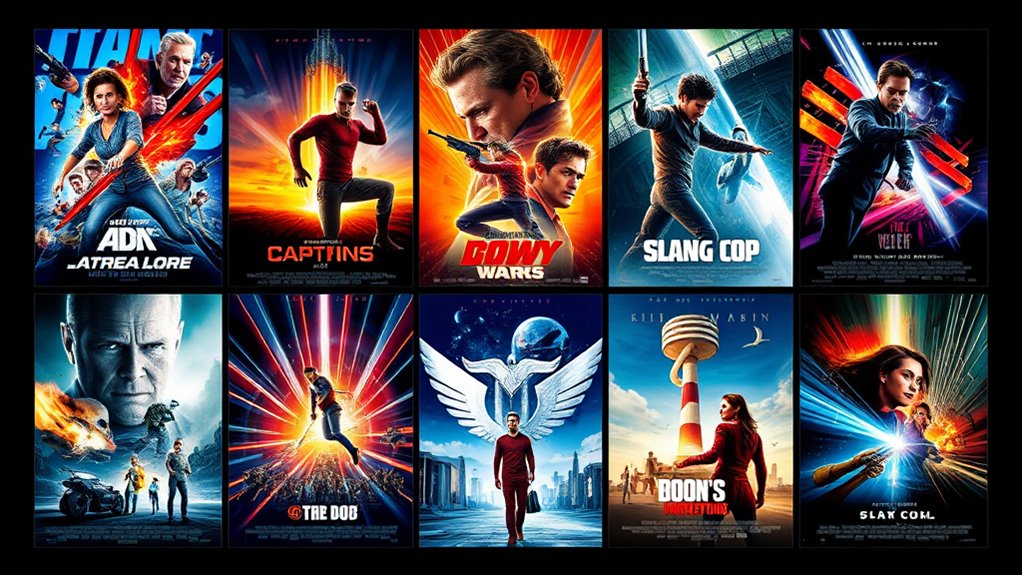Some films succeed at both the box office and with critics by blending audience expectations with fresh storytelling. These movies often align with genre norms while adding innovative elements that surprise viewers and impress critics alike. They manage to meet popular tastes and push creative boundaries, earning widespread acclaim and high ticket sales. If you want to explore these standout examples and discover how they bridge the gap, there’s plenty more to uncover below.
Key Takeaways
- Films that combine innovative storytelling with genre expectations can achieve both box-office success and critical acclaim.
- Genre-blending movies often appeal broadly, bridging audience preferences and critical recognition.
- Movies that subvert clichés or push boundaries tend to surprise viewers and critics alike, crossing the success divide.
- Managing audience expectations while introducing fresh perspectives helps films succeed commercially and critically.
- Iconic films like “The Dark Knight” and “Inception” exemplify how compelling storytelling can satisfy both critics and mass audiences.

When a movie hits the box office, it often signals widespread popularity, but that doesn’t always mean critics agree. You might find yourself excited by a blockbuster’s impressive ticket sales, yet critics may dismiss it as shallow or formulaic. This disconnect often stems from genre bias and audience expectations. Hollywood and viewers alike tend to have preconceived notions about what certain genres should deliver. For example, action films are expected to be adrenaline-pumping with minimal depth, while dramas are supposed to explore complex characters and themes. When a film aligns with these expectations, it tends to attract large audiences, boosting its box-office numbers, regardless of critical opinion. Conversely, movies that deviate from genre norms or challenge audience expectations might get overlooked by viewers but earn critical praise for their innovation or artistry.
Your perception of a film can be heavily influenced by these biases. If a romantic comedy doesn’t meet the usual beats you expect—predictable jokes, familiar tropes—you might feel disappointed, even if critics find it clever or invigoratingly different. Similarly, a gritty crime drama might be praised by critics for its realism, but if it’s not what you’re craving for a fun night out, you might dismiss its merits. This creates a tension between what the industry and audiences anticipate and what critics recognize as quality. Sometimes, this gap results in movies that succeed commercially but aren’t deemed “cinematic masterpieces,” or vice versa. Films like these challenge the idea that box-office success and critical acclaim are mutually exclusive, proving that audiences and critics often value different things.
Additionally, understanding the audience expectations and how they evolve can help explain why some films resonate differently with viewers and critics alike. When a film’s storytelling or style aligns with current trends or cultural themes, it’s more likely to bridge the gap effectively. When a film’s ability to bridge this gap lies in how well it manages audience expectations while offering something invigorating. When a movie surprises viewers with a new take on a familiar genre or subverts typical tropes, it can garner both box-office success and critical admiration. Think of films that blend genres or incorporate innovative storytelling techniques—these often attract broad audiences and earn critical praise simultaneously. Ultimately, the most memorable movies are those that manage to satisfy audience expectations without falling into genre bias, pushing boundaries enough to earn respect from critics while still drawing crowds. Bridging the gap between box-office hits and critical acclaim isn’t easy, but when it happens, it results in cinematic gems that stand the test of time.
Frequently Asked Questions
How Do Critics Influence Box Office Success?
Critics influence your box office success through their reviews and audience ratings. When critics praise a film, it boosts your confidence to see it, increasing ticket sales. Positive critic reviews often attract viewers who rely on expert opinions, while high audience ratings encourage others to join in. Conversely, negative reviews can deter audiences, reducing box office numbers. Your perception of a film is shaped markedly by critics’ insights and ratings.
Can a Film’s Genre Affect Its Critical and Commercial Reception?
You might think genres don’t matter, but they can totally shape how critics and audiences see a film. Genre biases can make a comedy seem shallow or a drama feel overly sentimental, which impacts critical reviews. Audience perceptions often follow these biases, affecting box office success. So, yes, a film’s genre can dramatically influence both critical acclaim and commercial performance, sometimes creating a huge gap or surprisingly bridging the two.
What Role Do Marketing Strategies Play in Bridging Box Office and Acclaim?
You can influence a film’s success by crafting smart marketing strategies. Viral campaigns generate buzz and attract diverse audiences, while brand partnerships expand visibility and credibility. When you leverage these tools effectively, you bridge the gap between box office performance and critical acclaim. By engaging viewers emotionally and fostering positive associations, your marketing helps guarantee the film resonates widely, possibly gaining both commercial and critical recognition.
Are There Examples of Films That Gained Popularity Over Time?
Imagine a seed planted in quiet soil, growing slowly into a mighty tree. Many films, like cult classics, gain popularity over time, blossoming into icons with longevity and reputation. These movies often start unnoticed but flourish through word of mouth and dedicated fans, proving that popularity isn’t always instant. Over years, they shine brighter, enthralling new generations and cementing their place in cinematic history.
How Do International Markets Impact a Film’s Overall Success?
International markets critically impact a film’s overall success by reflecting diverse cultural influences and regional preferences. You see, a film that resonates well globally can boost its revenue and reputation, even if it’s not a massive hit domestically. By understanding local tastes and cultural nuances, filmmakers can tailor content that appeals across borders. This broad appeal helps films thrive worldwide, proving that international markets are essential for long-term success.
Conclusion
So, next time a blockbuster hits the box office but gets mixed reviews, remember these films. They prove that fame and critical praise don’t always go hand in hand—sometimes, they even surprise us by doing both. It’s funny how the movies we least expect to be acclaimed can turn out to be the most beloved, and vice versa. After all, in the world of film, the biggest hits don’t always win the critics’ hearts.








